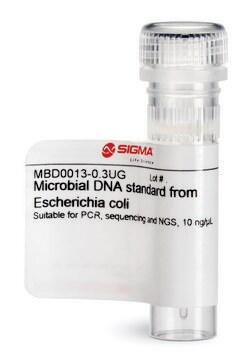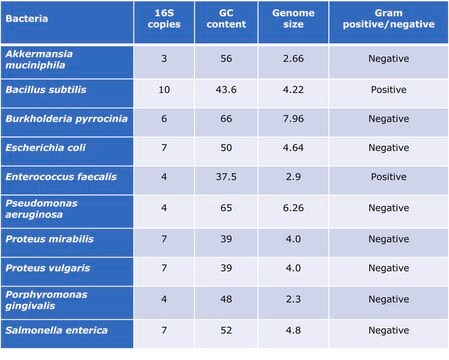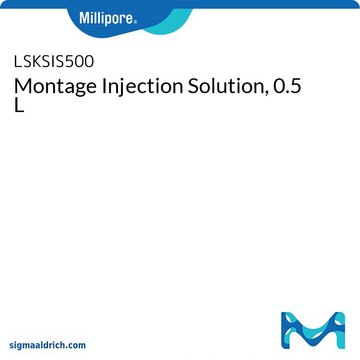MBD0005
Microbial DNA standard from Salmonella enterica
Suitable for PCR, sequencing and NGS, 10 ng/μL
Iniciar sesiónpara Ver la Fijación de precios por contrato y de la organización
About This Item
Código UNSPSC:
41105500
NACRES:
NA.24
Productos recomendados
Nivel de calidad
Formulario
liquid
concentración
10 ng/μL
técnicas
DNA extraction: suitable
DNA sequencing: suitable
PCR: suitable
Condiciones de envío
ambient
temp. de almacenamiento
−20°C
Categorías relacionadas
Descripción general
Standardization of sample analysis is currently needed in microbiome genomics research workflow. Lack of standardization can lead to biases and errors in common processes during sample preparation and analysis such as sample amplification, sequencing and bioinformatics analyses.1 Salmonella enterica genomic DNA microbial standard can serve as standard for benchmarking the performance along the workflow of microbiomics or meta-genomics analyses and as a tool to increase reproducibility and allow comparison of results obtained by different labs.
Salmonella enterica serotype Typhimurium (also S. Typhimurium) is a rod-shaped gram-negative bacterium of the family Enterobacteriaceae. It is an important food-borne pathogen that in humans causes intestinal inflammation, diarrhea, and the presence of neutrophils in stool samples.2 Growth of S. enterica in the gut lumen causes depletion of the healthy microbial community.3 Infection with Salmonella can induce inflammation and increase the risk for inflammatory bowel disease (IBD)4
Read here how to use our standards to ensure data integrity for your microbiome research.
Salmonella enterica serotype Typhimurium (also S. Typhimurium) is a rod-shaped gram-negative bacterium of the family Enterobacteriaceae. It is an important food-borne pathogen that in humans causes intestinal inflammation, diarrhea, and the presence of neutrophils in stool samples.2 Growth of S. enterica in the gut lumen causes depletion of the healthy microbial community.3 Infection with Salmonella can induce inflammation and increase the risk for inflammatory bowel disease (IBD)4
Read here how to use our standards to ensure data integrity for your microbiome research.
Aplicación
Suitable for Quantitative standard for PCR, Sequencing and NGS
Características y beneficios
- Individual microbial standard for microbiomics and meta-genomics workflow
- Suitable standard for PCR, sequencing and NGS
- Improve Bioinformatics analyses
- Increases reproducibility
- Compare results lab to lab
Forma física
Liquid -The genomic DNA is provided at ≥10 ng/μl concentration in TE buffer pH 8.0
Otras notas
Strain: Salmonella enterica subsp. enterica serovar Typhimurium strain
Código de clase de almacenamiento
12 - Non Combustible Liquids
Clase de riesgo para el agua (WGK)
WGK 1
Punto de inflamabilidad (°F)
Not applicable
Punto de inflamabilidad (°C)
Not applicable
Elija entre una de las versiones más recientes:
Certificados de análisis (COA)
Lot/Batch Number
¿No ve la versión correcta?
Si necesita una versión concreta, puede buscar un certificado específico por el número de lote.
¿Ya tiene este producto?
Encuentre la documentación para los productos que ha comprado recientemente en la Biblioteca de documentos.
Fecal leukocytes in diarrheal illness.
J C Harris et al.
Annals of internal medicine, 76(5), 697-703 (1972-05-01)
Inna Sekirov et al.
Gut microbes, 1(1), 30-41 (2011-02-18)
Gastrointestinal infections involve an interactive tripartite relationship between the invading pathogen, the host, and the host's resident intestinal microbiota. To characterize the host inflammatory response and microbiota alterations during enteric salmonellosis, C57BL/6 mice were pre-treated with a low dose of
Kim O Gradel et al.
Gastroenterology, 137(2), 495-501 (2009-04-14)
Various commensal enteric and potentially pathogenic bacteria may be involved in the pathogenesis of inflammatory bowel diseases (IBD). We compared the risk of IBD between a cohort of patients with documented Salmonella or Campylobacter gastroenteritis and an age- and gender-matched
J Paul Brooks et al.
BMC microbiology, 15, 66-66 (2015-04-17)
Characterizing microbial communities via next-generation sequencing is subject to a number of pitfalls involving sample processing. The observed community composition can be a severe distortion of the quantities of bacteria actually present in the microbiome, hampering analysis and threatening the
Nuestro equipo de científicos tiene experiencia en todas las áreas de investigación: Ciencias de la vida, Ciencia de los materiales, Síntesis química, Cromatografía, Analítica y muchas otras.
Póngase en contacto con el Servicio técnico








